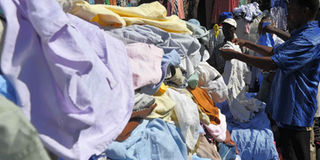With mitumba ban in tatters, what next for trade between Kenya, US?

A man samples second-hand clothes (locally known as mitumba) at the Gikomba open-air market, Nairobi. PHOTO | FILE | NATION MEDIA GROUP
What you need to know:
In 2017, the trade with the US was valued at Sh126 billion, more than half of it benefiting America.
Under Agoa, Kenya sold about Sh40 billion worth of textiles and clothing to the US, while Uganda, Rwanda and Tanzania sold a cumulative Sh4.3 billion.
Agoa was started by President George W Bush to help African countries access US markets.
The East African Community had given itself up to 2019 to begin stopping the importation of second hand clothes from the United States.
In 2016, the presidents of Kenya, Burundi, Tanzania, Uganda and Rwanda said taking the move would protect their textile and leather industries.
It did not take long before things began falling apart. First, the Secondary Materials and Recycled Textiles Association, a US lobby, argued that the ban would amount to a trade barrier, violating the Africa Growth Opportunity Act (Agoa).
The Act allows no tariffs on particular goods from Africa.
Then, the US Government started issuing warnings to EAC countries: If any ban was imposed, the states would lose the privilege of selling goods to America.
Last year, Kenya pulled out of the EAC ‘mitumba’ ban deal. The then Trade Cabinet Secretary Adan Mohammed said the government was letting market forces determine what Kenyans want to buy.
TEXTILE INDUSTRY
“It is, of course, our desire to develop and promote our textile industry and create more jobs,” he said.
“Through the transition of market forces, we would like ‘mitumba’ to compete with clothes that are produced within East Africa, within Kenya. If those products are more competitive and more consumer-friendly, then you will see a reduction in the ‘mitumba’ business.”
Kenya, Tanzania and Uganda survived the suspension, but Rwanda, which went ahead with the plan, was recently removed from the Agoa beneficiaries list.
For the US, an open ‘mitumba’ market will guarantee the estimated $120 million sales into EAC. Kenya, through Agoa, has sold goods valued at $256 million (Sh25.6 billion) to the US this year, mainly clothing under this arrangement, according to the US Census Bureau.
In 2017, the trade with the US was valued at Sh126 billion, more than half of it benefiting America.
Under Agoa, Kenya sold about Sh40 billion worth of textiles and clothing to the US, while Uganda, Rwanda and Tanzania sold a cumulative Sh4.3 billion.
60,000 JOBS
In rescinding the ban, Kenyan officials argued that more than 60,000 jobs in the textile industry were under threat.
Yet President Donald Trump has always emphasised the "America First" policy when engaging with other parties and countries.
When Trump first made contact with President Uhuru Kenyatta last year, a White House read-out of the call said the two “discussed our economic partnership and mutual dedication to overcoming terrorism and other regional security challenges through close cooperation”.
Politically, the meeting between presidents Kenyatta and Trump could benefit Kenya’s image, argues Mr Benard Ayieko, an economist and commentator on trade and investment.
“It is also an opportunity for the President to engage his US counterpart on interventions that will reduce the trade imbalance. The US remains a key source of tourists to Kenya. They thus need to discuss challenges that stop Americans from arriving for holidays in droves,” he said.
MORE TRADE
Observers say Kenya will draw little if she fails to push for more trade with the US.
“We need to change gears from the tradition of selling primary commodities. Most of our exports are apparel, which are not even manufactured Kenyan companies,” Mr Clement Onyango, the director of the think-tank CUTS International, told the Nation.
“We need lots of value addition because Kenya is an agriculture-based economy. Many American firms have done this bit so well, in food processing, ICT and e-commerce. These are the areas that the President can facilitate cross-feritilisation of ideas.”
Ahead of the meeting, Foreign Affairs CS Monica Juma spoke of Africa’s engagement with the US, after Agoa expires in 2025.
ACCESS US MARKETS
Agoa was started by President George W Bush to help African countries access US markets.
But it also requires beneficiaries to eliminate trade barriers or at least show progress in doing so.
“The policy advantages of Agoa have enabled entire industries to emerge in many countries, such as textile exports in Kenya,” the minister told African diplomats in Washington on Wednesday.
“Regrettably, these Agoa policy advantages have not translated to firm-level advantages that define world beaters with the inevitable lifting of the preferences.”
According to Dr Juma, Africa can improve on that by adopting the Continental Free Trade Area agreement, signed early this year to open up markets as a way of dealing with any vacuum left with the expiry of Agoa.





